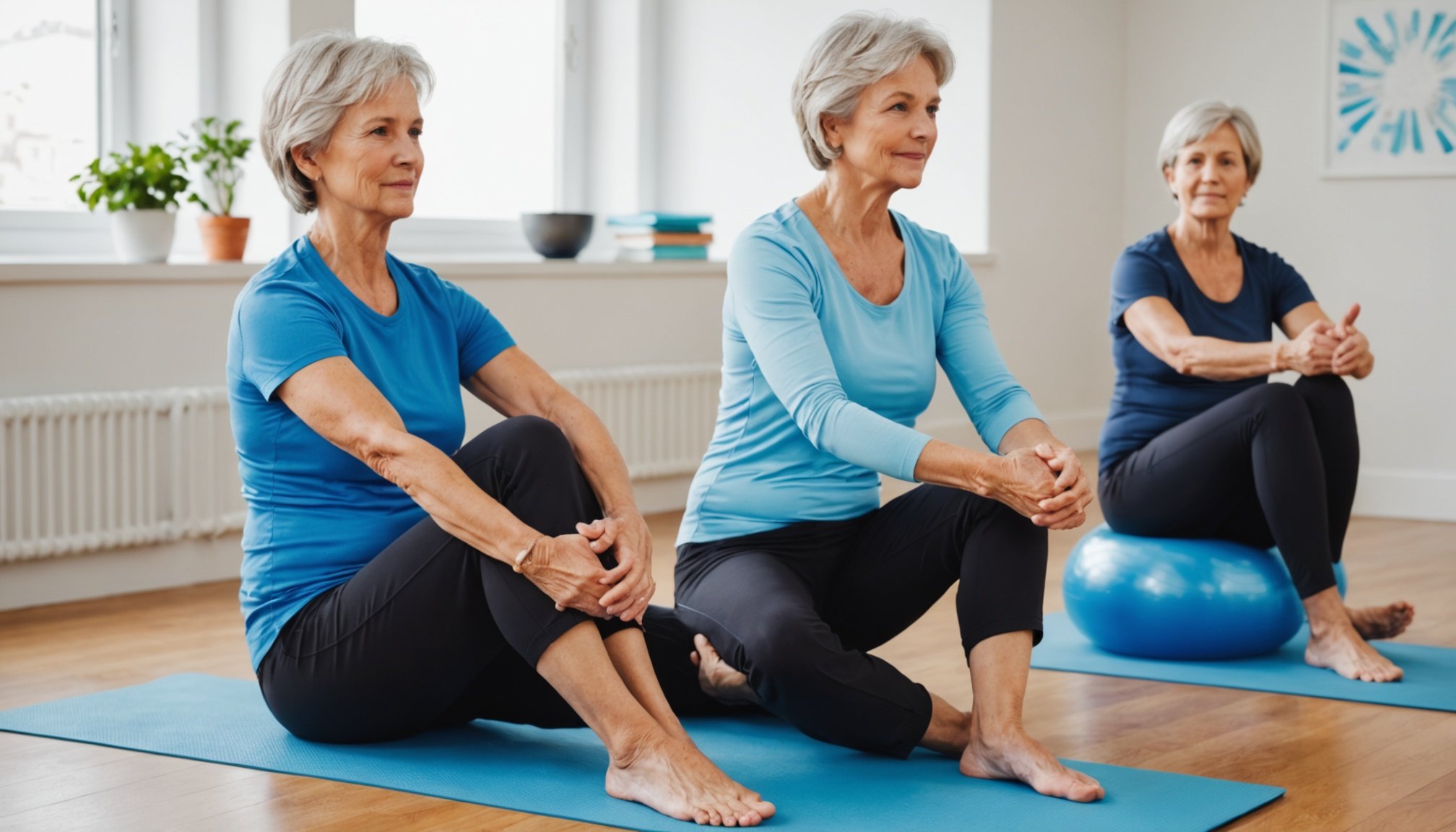Importance of Pelvic Muscle Strength for Older Women
Pelvic muscle strength serves as a fundamental aspect of women’s health, particularly for older women. These muscles support the bladder, bowel, and uterus, playing a vital role in core stability. Proper pelvic muscle function is crucial as it impacts posture, balance, and the ability to perform daily activities without discomfort.
Core stability, significantly influenced by pelvic strength, is instrumental in maintaining the flexibility and coordination necessary for executing everyday actions, such as walking, bending, and lifting. A lack of pelvic muscle strength can lead to issues like incontinence, pelvic organ prolapse and negatively affect overall mobility. It’s critical for older women to engage in exercises aiming to bolster these muscles to sustain their quality of life.
Also to see : Exploring Acupuncture: A Potential Solution for Tinnitus Relief in Seniors
Statistics highlight that pelvic health problems are prevalent, with a notable percentage of older women experiencing decreased muscle strength in this area. This decline is not only a health concern but also influences social and psychological well-being. An increased awareness of pelvic muscle strength and suitable intervention strategies can help mitigate these issues, reaffirming the importance of dedicated exercises for maintaining and improving both pelvic strength and core stability. By focusing on these aspects, older women can promote a healthier, more active lifestyle.
Effective Exercises for Pelvic Muscle Strength
Strengthening pelvic muscles is crucial for overall core health, especially for older women. Proper exercise can lead to better stability and improved posture.
Additional reading : Essential Dietary Changes for Seniors Managing Hypothyroidism: A Comprehensive Guide
Basic Kegel Exercises
Kegel exercises are foundational in strengthening pelvic muscles. They involve contracting and relaxing the pelvic floor muscles. To perform a Kegel, imagine you’re trying to stop the flow of urine and hold the contraction for 5 seconds, relaxing for 5 seconds. Repeat this 10 times in a session, working up to 3 sessions a day. Practising regularly can enhance muscle endurance over time.
Bridge Exercise
The bridge exercise targets not only the pelvic muscles but also the glutes and lower back. To do it, lie on your back with knees bent and feet flat on the floor. Lift your hips towards the ceiling while squeezing your glutes and keeping your core engaged. Hold for 5 seconds before lowering. Repeat this exercise 10-15 times. Variations include holding one leg up for increased difficulty.
Squats
Squats are excellent for overall core exercises. Stand with feet shoulder-width apart, lower into a squat by bending hips and knees while keeping the chest up. Press back to stand. For beginners, squats can be done using a chair for support. Aim for 15 repetitions per set. This can improve leg and pelvic strength together.
Incorporating Exercises into Daily Routine
Integrating a daily exercise routine into your schedule can significantly enhance your well-being. Focusing on pelvic strengthening is particularly beneficial for maintaining a healthier lifestyle. Start by scheduling specific times during your week for these exercises, ensuring you create a balanced routine. Consistency is key to achieving long-term benefits.
Pelvic exercises can be incorporated into your everyday tasks seamlessly. For instance, you might perform pelvic strengthening exercises during your morning or evening routine, making them an integral part of your day. This approach ensures that exercises are not neglected, even during busy schedules. Engaging in these activities consistently helps in building strength over time.
To further integrate exercises, consider pairing them with activities you already enjoy. This could mean practicing pelvic strengthening while watching your favourite show or during a leisurely walk in the park. By doing so, you are more likely to stick with your exercise routine, turning it into a natural part of your life.
Establishing such a routine promotes a healthier lifestyle, gradually transforming your overall physical health and well-being. Remember, the key lies in consistency and the clever integration of exercises into daily life.
Benefits of Strengthening Pelvic Muscles
Enhancing the strength of pelvic muscles offers various advantages that contribute to both short-term and long-term well-being. Notably, it improves core stability which is essential for maintaining balance and coordination, particularly as one ages. A stable core not only supports day-to-day activities but also reduces the risk of falls and injuries.
Pelvic exercises are proven to alleviate issues like urinary incontinence and pelvic pain, offering significant health improvements. This reduction in discomfort can be transformative, especially for those who experience these issues post-childbirth or during aging. Consistent exercises help manage and often diminish these challenges, promoting a better quality of life.
Additionally, improved sexual health is a critical benefit of performing pelvic strength exercises. Enhanced muscle control can lead to more enjoyable intimate experiences and has been linked to increased satisfaction and better physical health.
Incorporating pelvic exercises into daily routines can empower individuals to age well, staying active and independent longer. It is a simple yet profound commitment to personal health, impacting numerous aspects of daily life, long-term health, and well-being. Embracing these exercises offers a proactive approach to maintaining health improvements through various stages of life.
Safety Tips and Considerations
Navigating a fitness journey requires careful attention, especially for older women. It’s crucial to take certain safety precautions to ensure that exercise remains beneficial rather than detrimental. Consulting with a healthcare provider before embarking on any exercise program is the primary step. Professionals can offer tailored advice, ensuring workouts are both safe and effective.
Listening to your body is another pivotal element in exercising safely. Overexertion can lead to injuries and setbacks, so it’s important to recognise personal limits. If discomfort or pain arises, it may be necessary to adjust the intensity or form of the exercise.
For those who face mobility challenges, investing in adaptive equipment or aids can make all the difference. These tools are designed to support and enhance physical capabilities, allowing individuals to perform exercises comfortably and securely. Adaptive options such as supportive shoes, resistance bands, or stability balls can provide stability and reduce the risk of falls or strains.
Incorporating these safety measures enables older women to reap the benefits of fitness while minimising potential hazards. Exercise safety should always be a priority, ensuring a positive and sustainable fitness experience.
Additional Resources and Support
Pelvic health support is essential for maintaining women’s well-being, particularly as they age. Several women’s health resources offer comprehensive guides and support systems to address these needs effectively. Understanding and accessing these resources is key to finding suitable solutions for personal health.
Local community programs often run workshops focusing on pelvic strengthening exercises. These programs provide both physical and emotional support, which can significantly benefit older women. Participants can learn from success stories shared by others who have improved their pelvic health through dedicated practices. Classes within these programs are tailored to different experience levels and offer a positive learning environment.
Moreover, many organizations offer online forums for women to exchange insights and experiences regarding pelvic health. These communities can be a valuable source of encouragement and information.
Testimonials emphasize the life-altering impact that professional guidance and community support can have. Women who have engaged with these programs often report enhanced physical comfort, increased confidence in their daily activities, and a greater sense of community and shared purpose.
Seeking out and investing time in these supportive environments can unlock tangible benefits in pelvic health and overall well-being.











